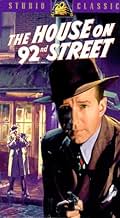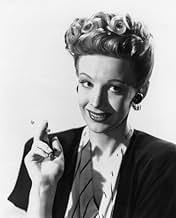NOTE IMDb
6,6/10
3,5 k
MA NOTE
Ajouter une intrigue dans votre langueBill Dietrich becomes a double agent for the F.B.I. in a German spy ring.Bill Dietrich becomes a double agent for the F.B.I. in a German spy ring.Bill Dietrich becomes a double agent for the F.B.I. in a German spy ring.
- Réalisation
- Scénario
- Casting principal
- Récompensé par 1 Oscar
- 4 victoires au total
William Post Jr.
- Walker
- (as William Post)
William Adams
- Customs Officer
- (non crédité)
Frieda Altman
- Saboteur
- (non crédité)
William Beach
- Saboteur
- (non crédité)
Carl Benson
- German Spy Trainee
- (non crédité)
Hamilton Benz
- Saboteur
- (non crédité)
Avis à la une
"The House on 92nd Street" is a 1945 film about the FBI's attempts to break up a spy ring during the war. A young man, William Dietrich (William Eythe), who has been recruited by the Nazis as a spy, informs the FBI of this and becomes their mole inside the organization. One of Dietrich's goals is to get the identity of the mysterious "Mr. Christopher" who gives all of the orders.
This is a black and white film with strong narration that probably had a great impact at the time of its release. Though the machinery used in the movie looks archaic now, back then it must have been fascinating for an audience to watch and seemed very high-tech. Plus some of the material being transmitted had to do with the top-secret atom bomb, which at the time of the film, had just been dropped.
The cast is small, consisting of Eythe, Lloyd Nolan, Leo G. Carroll, Signe Hasso, Gene Lockhart, and Lydia St. Clair. They're all solid. For a change, the women, Hasso and St. Clair, have the strongest roles in the film, and they give striking performances. Eythe was getting the big star build-up at 20th Century Fox. Since it was wartime, he could have made a place for himself at the studio the way that Dana Andrews did. However, when gay rumors reached Darryl Zanuck, Eythe's path became a rocky one, leading nowhere, as the studio continually demoted him and eventually got rid of him.
Well worth seeing.
This is a black and white film with strong narration that probably had a great impact at the time of its release. Though the machinery used in the movie looks archaic now, back then it must have been fascinating for an audience to watch and seemed very high-tech. Plus some of the material being transmitted had to do with the top-secret atom bomb, which at the time of the film, had just been dropped.
The cast is small, consisting of Eythe, Lloyd Nolan, Leo G. Carroll, Signe Hasso, Gene Lockhart, and Lydia St. Clair. They're all solid. For a change, the women, Hasso and St. Clair, have the strongest roles in the film, and they give striking performances. Eythe was getting the big star build-up at 20th Century Fox. Since it was wartime, he could have made a place for himself at the studio the way that Dana Andrews did. However, when gay rumors reached Darryl Zanuck, Eythe's path became a rocky one, leading nowhere, as the studio continually demoted him and eventually got rid of him.
Well worth seeing.
When this film was made in the 1940's, the ultimate evil that is Adolph Hilter and the Nazi movement was still a serious threat to our way of life. Lloyd Nolan, a major star of the 30's and 40's, gives his usual strong performance as FBI Agent Briggs, in charge of the Nazi spy case. Leo G. Carroll steals the movie playing the Nazi spymaster. Enjoy this film and remember why our fathers and grandfathers fought WWII. As a side note, real FBI agents appeared in this movie in support roles at the direction of J. Edgar Hoover, who gave his full co-operation to the producers.
This semi documentary film, shows the FBI at work in those early days of the European conflict. Henry Hathaway, the director, focus on the work behind the scenes of a group of German spies, operating in New York and how the FBI is able to infiltrate the group.
The film, as seen today, still holds the viewer's attention, although the technology is obsolete by today standards. We are given a suspenseful story about the group that established the base of operations in the house on 92nd Street and Madison Avenue in the Manhattan of the 40s. The crisp black and white cinematography by Norbert Brodine still looks pristine and sharp.
The cast headed by Lloyd Nolan as Briggs, do a good job under Mr. Hathaway's direction. Best of all is Signe Hasso as Elsa Gebhart, the designing woman with a lot of secrets. Leo G. Carroll is also seen as one of the spies. Gene Lockhart also has a minor role.
It was fun to watch uncredited New York based actors in the background such as E.G. Marshall, Vincent Gardenia, Paul Ford, among others making small contributions to the film.
The film, as seen today, still holds the viewer's attention, although the technology is obsolete by today standards. We are given a suspenseful story about the group that established the base of operations in the house on 92nd Street and Madison Avenue in the Manhattan of the 40s. The crisp black and white cinematography by Norbert Brodine still looks pristine and sharp.
The cast headed by Lloyd Nolan as Briggs, do a good job under Mr. Hathaway's direction. Best of all is Signe Hasso as Elsa Gebhart, the designing woman with a lot of secrets. Leo G. Carroll is also seen as one of the spies. Gene Lockhart also has a minor role.
It was fun to watch uncredited New York based actors in the background such as E.G. Marshall, Vincent Gardenia, Paul Ford, among others making small contributions to the film.
The highly gifted natural and trained talent of Lloyd Nolan adorns this story of espionage and counterespionage in the US just prior to and after WWII was declared.
Playing a key FBI agent, Nolan displays the totally convincing work he rendered throughout his career. He heads a strong cast: Signe Hasso and Leo G. Carroll offer solid performances, and William Ethye is a good leading man.
Director Henry Hathaway mixes in authentic newsreel footage with care and balance. The result is a well done docudrama of the mid 40s.
It looks as though 20th Century Fox made a pact with the FBI for this project, with almost the complete Bureau being utilized for the shoot. The films emerges as a supreme tribute to the branch, with Chief Hoover's name frequently in evidence.
The work technically qualifies as propaganda, in which patriotic appreciation and support for the war effort is forthrightly projected.
Playing a key FBI agent, Nolan displays the totally convincing work he rendered throughout his career. He heads a strong cast: Signe Hasso and Leo G. Carroll offer solid performances, and William Ethye is a good leading man.
Director Henry Hathaway mixes in authentic newsreel footage with care and balance. The result is a well done docudrama of the mid 40s.
It looks as though 20th Century Fox made a pact with the FBI for this project, with almost the complete Bureau being utilized for the shoot. The films emerges as a supreme tribute to the branch, with Chief Hoover's name frequently in evidence.
The work technically qualifies as propaganda, in which patriotic appreciation and support for the war effort is forthrightly projected.
Henry Hathaway directed this spy film presented in semi-documentary fashion starring Lloyd Nolan as FBI Inspector George Briggs, who is in charge of the counter-terrorist division that recruits German-speaking William Dietrich(played by William Eythe) to infiltrate a cell of German spies sent to America to gather information on the construction of the atomic bomb. The FBI allows its 92nd. street headquarters to remain open in order to identify its highest-level operatives, which involve a Mr. Christopher, though Dietrich's main contact is a woman(played by Signe Hasso) How long before he can identify his targets, or end up identified himself? Fine film effectively uses the semi-documentary approach, with Lloyd Nolan the standout, and would reprise the role in semi-sequel "The Street With No Name".
Le saviez-vous
- AnecdotesThe movie deals with the theft by German spies of the fictional "Process 97", a secret formula which, the narrator tells us, "was crucial to the development of the atomic bomb." The movie was released on September 10, 1945, only a month after the atomic bombs had been dropped on Japan, and barely a week after Japan's formal surrender. While making the film, the actors and Director Henry Hathaway did not know that the atomic bomb existed, nor that it would be incorporated as a story element in the movie. (None of the actors in the film mentioned the atomic bomb.) However, co-Director and Producer Louis De Rochemont (who produced the "March of Time" newsreel films) and Narrator Reed Hadley were involved in producing government films on the development of the atomic bomb. (Hadley was present at the final test of the bomb in Los Alamos, New Mexico, in July, 1945.) After the bomb was dropped on Hiroshima, Hadley and Screenwriter John Monks, Jr. hastily wrote some additional voice-over narration linking "Process 97" to the atomic bomb, and Rochemont inserted it into the picture in time for the film's quick release.
- GaffesThe description of a one-way mirror as an "X-ray" mirror at the beginning is nonsense. A one-way mirror is in fact merely a partially-silvered mirror. It becomes "one-way" by virtue of different lighting on either side - one side dimly lit, the other brightly lit. From the side that's brightly lit, it appears to be a normal mirror because the reflection washes out any light coming through from the dim side. But from within the dim side, everything on the bright side is readily visible because the light coming through predominates over the reflection seen from the dim side.
- Citations
Agent George A. Briggs: We know all about you, Roper. We've traced you to the day you were born. We even know the approximate day you will die.
- Crédits fousOpening credits are shown as someone flipping through the pages of a file.
- ConnexionsReferenced in À vingt-trois pas du mystère (1956)
- Bandes originalesTra-La-La-La
(uncredited)
Music by Harry Warren
Played as background music at the talent agent's office
Meilleurs choix
Connectez-vous pour évaluer et suivre la liste de favoris afin de recevoir des recommandations personnalisées
- How long is The House on 92nd Street?Alimenté par Alexa
Détails
- Date de sortie
- Pays d’origine
- Langues
- Aussi connu sous le nom de
- La maison de la 92ème rue
- Lieux de tournage
- Hambourg, Allemagne(second unit)
- Société de production
- Voir plus de crédits d'entreprise sur IMDbPro
Box-office
- Montant brut aux États-Unis et au Canada
- 2 500 000 $US
- Durée1 heure 28 minutes
- Couleur
- Rapport de forme
- 1.37 : 1
Contribuer à cette page
Suggérer une modification ou ajouter du contenu manquant

Lacune principale
What is the French language plot outline for La maison de la 92e rue (1945)?
Répondre





























